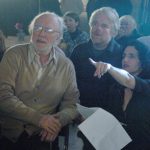The Business of Art: On Grant Applications
Writing Between the Lines
When it comes to writing about their work, many artists have the same complaint: if I could write it, I wouldn’t need to paint/compose/perform it! Writing about your work can be difficult, and doing so in the context of asking for money can be even more intimidating, but when you find a grant opportunity that’s perfect for you, following some of the steps outlined below will help you create the best application possible.
Decide What You’re Looking For
While money may be the first thing that comes to mind when you think of the word “grant,” take a moment to think about your goals. If what you really want is more time in the studio to explore and create without having a project in mind, you may benefit most from a residency. If you want to complete a project that will result in a public presentation, performance, or publication within a certain timeframe, you should be looking for grants that are based on the outcomes of your project.
General Application Tips
- Read the application through carefully before you begin and make a checklist of application materials if one is not provided for you so you don’t forget anything;
- Never leave a question blank or ignore something stated in the guidelines. Call the program officer at the grant-making organization if you are unsure about your eligibility or how to answer something. Program officers are the public interfaces for foundations, and part of their job is to speak with applicants and answer questions;
- Use section headers and bullet-pointed lists to break up long blocks of text. Your application should be easy to read in a short amount of time;
- Have a non-artist friend read over your application before you submit to help gauge readability—as well as to help check for typos;
- When mailing an application or work samples, determine if the deadline is a “received by” date or a postmark date.
Putting Your Best Foot Forward
Every grantmaking organization has different priorities; by taking a few minutes to tailor your proposal, artist statement, and work samples to best appeal to each program, you’ll increase your chances of being recognized. Panels, boards, and program officers may be reviewing thousands of applications—one that speaks directly to their interests and reflects the passion of the applicant will be much better received than an application that feels generic and unspecific. Don’t be afraid to tell yourself no. If you apply for something when your project doesn’t meet the foundation’s guidelines, you’ll look like you didn’t read the application.
Reading Between the Lines
Guidelines will appear on the websites or forms of any foundation that is accepting applications. These are the “rules” of what or who the foundation awards grants to, and knowing how to read them can provide clues as to what to focus on in your application. For example, here are the guidelines used for NYFA’s Artists’ Fellowships, as articulated on the application:
“Artists’ Fellowships are chosen based on the single criterion of work that demonstrates a compelling vision (my emphasis) as defined by the assembled panel’s collective opinion.”
Since nothing is mentioned about what you are expected to do with the award, the stage of career you should be at, or an artist’s statement, you can deduct that work samples are going to be the most important part of the application. Therefore, you should make sure you have high-quality work samples that will best demonstrate your vision. Make sure you submit your work samples in the formation specified by the organization; many grantmakers now accept online submissions of digital images, while others still ask for slides.
Here are some application questions from the Asian Women Giving Circle’s grant program for artists:
“Describe how your project is advancing gender equity and how it is focused on social change outcomes… how are the arts integral to the project?”“Explain how your activities will promote social change in the lives of Asian American women and girls in New York City. Give examples of how the project will interact with that community.”
Because the socially relevant outcomes of proposed art projects are clearly important to the organization, your narrative should focus on the community problems that need to be met and the final results, rather than artistic technique. In this case, a good proposal will first give concrete examples of the social challenges faced by Asian American women and girls in New York City, then briefly describe the project (i.e.what the project is) before going into a longer explanation of how the project will address and impact these challenges.
For detailed project narratives, make sure to use the same terminology as the organization has used. For example, “This project will advance gender equity by….” You should also consider using bolded section headers to break up large blocks of text so the person reviewing your proposal does not have to spend time looking for your Summary, Timeline, Outcomes, Personnel Bios, and other required information.
Your Artist’s “Toolbelt”
Most grant programs for individual artists will ask for a Bio, Statement, and Resume. Think of these things as your “toolbelt”—once you have them, you can use them to apply for multiple grants without starting from scratch each time, keeping in mind that a statement should be revised continually to best fit the program being applied to.
- Bio: Your artist biography is a one-paragraph summary of where you’re from, your past and most recent work, and a mention of your most major award(s), exhibitions/recordings/performances/publishing venues, and other accomplishment(s). This should focus on your life as a artist only; it’s unnecessary to mention your day job or other careers.
- Statement: An artist’s statement is a one-page document that contextualizes your work and the ideas that inform it. It should discuss your media and techniques and state how you want viewers/listeners/readers to interact with your work. When submitting a proposal, your statement should clearly reference or relate to the work samples you’ve submitted (you may even refer to a specific work as an example of something that typifies your style or technique). If you work in multiple disciplines or styles, you may have multiple artist’s statements that you use for different purposes. Clear, concise statements that provide real insight into a body of work will stick out in the crowd—something you want your statement to do in the pile of applications!
- Resume: Your artist’s resume is a list of your art achievements (different from your work resume). It should take the form of an organized list—not a paragraph. For a visual artist, it should list solo exhibitions/publications, group exhibitions/publications, performances, teaching or lecturing experience, awards, press, collections, and your own education (BA, BFA, MFA). Your resume may be more than one page, but try to keep it concise. If you have many years’ worth of experience, you may want to only include “selected exhibitions,” the most recent or prominent shows.
Remember that many artists do not have a resume loaded with achievements. Do not get intimidated by the feeling that your artistic career is not “substantial” enough for a grant. Grantmakers want to see your bio and resume so they can gauge where you are in your career, and unless the grant is specifically for “master” artists (such as the Gottlieb Foundation’s), in the panel review room decisions are never made only based on who has had more exhibitions or who has been an artist longer. Getting the knack of grantwriting definitely takes some practice and some patience, but it’s a skill that can take you far once you’re willing to take control. Aside from the immediate reward of cash, many artists state that years later (after the money is gone) the feeling of peer recognition and validation for themselves as an artist still resonates as the most meaningful part of the grant.
Brigid Flynn has been NYFA’s Institutional Giving Officer since 2005 and has been writing grants for seven years. She also leads “Inside the Grants Process” workshops for artists at NYFA.





